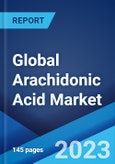The global arachidonic acid market size reached US$ 257.1 Billion in 2022. Looking forward, the market is expected to reach US$ 356.6 Billion by 2028, exhibiting a growth rate (CAGR) of 5.60% during 2022-2028.
Arachidonic acid is a long-chain essential fatty acid used by the human body to synthesize unsaturated carboxylic acids. It is usually consumed in small quantities and is extracted from various food sources, such as poultry, eggs, fish and animal meat. It can also be obtained from mosses and algae. It is commonly available in dry and liquid forms and is added to various food products, dietary supplements, infant formula and pharmaceuticals. Arachidonic acid is combined with docosahexaenoic acid (DHA) to stimulate growth and development in children and send signals to the cell membranes to initiate adaptive changes in case of muscle damage. It is administered through tablets, injections and syrups to meet the nutritional requirements of both adults and children.
Arachidonic acid is a long-chain essential fatty acid used by the human body to synthesize unsaturated carboxylic acids. It is usually consumed in small quantities and is extracted from various food sources, such as poultry, eggs, fish and animal meat. It can also be obtained from mosses and algae. It is commonly available in dry and liquid forms and is added to various food products, dietary supplements, infant formula and pharmaceuticals. Arachidonic acid is combined with docosahexaenoic acid (DHA) to stimulate growth and development in children and send signals to the cell membranes to initiate adaptive changes in case of muscle damage. It is administered through tablets, injections and syrups to meet the nutritional requirements of both adults and children.
Arachidonic Acid Market Trends
The increasing consciousness regarding child nutrition among the masses is one of the key factors creating driving the market growth. Arachidonic acid is added to women's nutrition and baby food products to promote the development of eyesight, immune response, memory and cell membranes in the body. Moreover, the rising incidence of lifestyle-related disorders leading to the increasing demand for dietary supplements is providing a thrust to the market growth. Consumer preference is rapidly shifting toward premium-quality oil-based nutritional supplements containing essential fatty acids to meet the daily nutritional requirements and lead a healthy lifestyle. In line with this, the increasing demand for sports supplements among the masses is also contributing to the growth of the market. Other factors, including extensive research and development (R&D) activities in the field of biotechnology, along with the increasing consumer awareness regarding the benefits of maintaining adequate nutrition in their diet, are anticipated to drive the market toward growth.Key Market Segmentation
This research provides an analysis of the key trends in each sub-segment of the global arachidonic acid market report, along with forecasts at the global, regional and country level from 2023-2028. The report has categorized the market based on source, form and end user.Breakup by Source:
- Animal
- Plant
Breakup by Form:
- Dry
- Liquid
Breakup by End User:
- Food and Beverage
- Pharmaceuticals
Breakup by Region:
- North America
- United States
- Canada
- Asia-Pacific
- China
- Japan
- India
- South Korea
- Australia
- Indonesia
- Europe
- Germany
- France
- United Kingdom
- Italy
- Spain
- Russia
- Latin America
- Brazil
- Mexico
- Middle East and Africa
Competitive Landscape
The competitive landscape of the industry has also been examined along with the profiles of the key players being BASF SE, Bio-Techne Corporation, Cargill Incorporated, Cayman Chemical Company, Croda International Plc, Kingdomway Nutrition Inc., Koninklijke DSM N.V. and Merck KGaA.Key Questions Answered in This Report:
- How has the global arachidonic acid market performed so far and how will it perform in the coming years?
- What has been the impact of COVID-19 on the global arachidonic acid market?
- What are the key regional markets?
- What is the breakup of the market based on the source?
- What is the breakup of the market based on the form?
- What is the breakup of the market based on the end user?
- What are the various stages in the value chain of the industry?
- What are the key driving factors and challenges in the industry?
- What is the structure of the global arachidonic acid market and who are the key players?
- What is the degree of competition in the industry?
Table of Contents
1 Preface3 Executive Summary11 Value Chain Analysis13 Price Analysis
2 Scope and Methodology
4 Introduction
5 Global Arachidonic Acid Market
6 Market Breakup by Source
7 Market Breakup by Form
8 Market Breakup by End User
9 Market Breakup by Region
10 SWOT Analysis
12 Porters Five Forces Analysis
14 Competitive Landscape
Companies Mentioned
- BASF SE
- Bio-Techne Corporation
- Cargill Incorporated
- Cayman Chemical Company
- Croda International Plc
- Kingdomway Nutrition Inc.
- Koninklijke DSM N.V.
- Merck KGaA
Methodology

LOADING...
Table Information
| Report Attribute | Details |
|---|---|
| No. of Pages | 145 |
| Published | November 2023 |
| Forecast Period | 2022 - 2028 |
| Estimated Market Value ( USD | $ 257.1 Billion |
| Forecasted Market Value ( USD | $ 356.6 Billion |
| Compound Annual Growth Rate | 5.6% |
| Regions Covered | Global |
| No. of Companies Mentioned | 8 |









